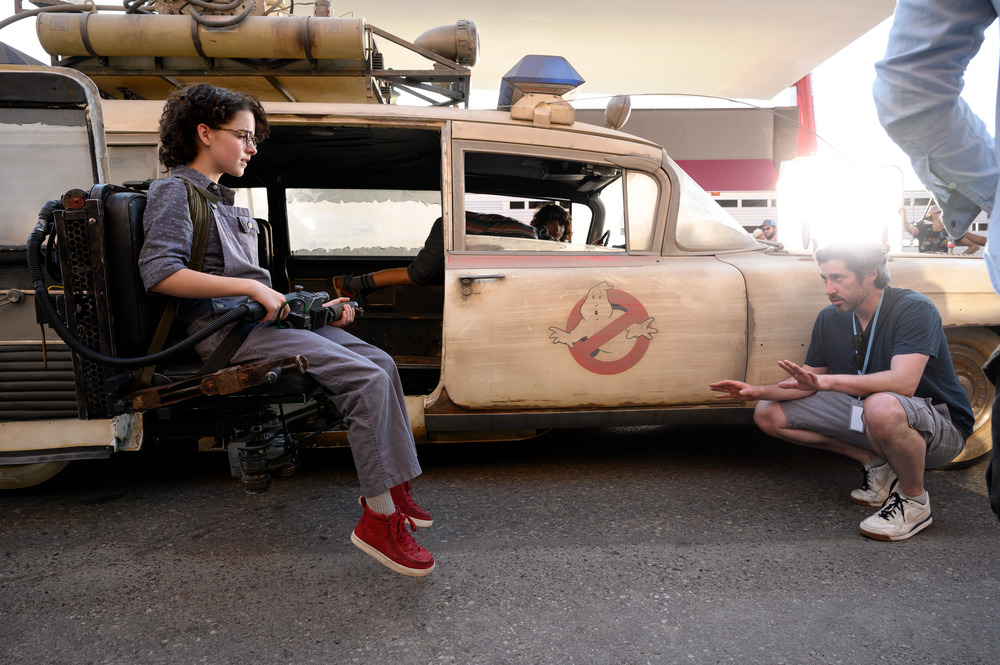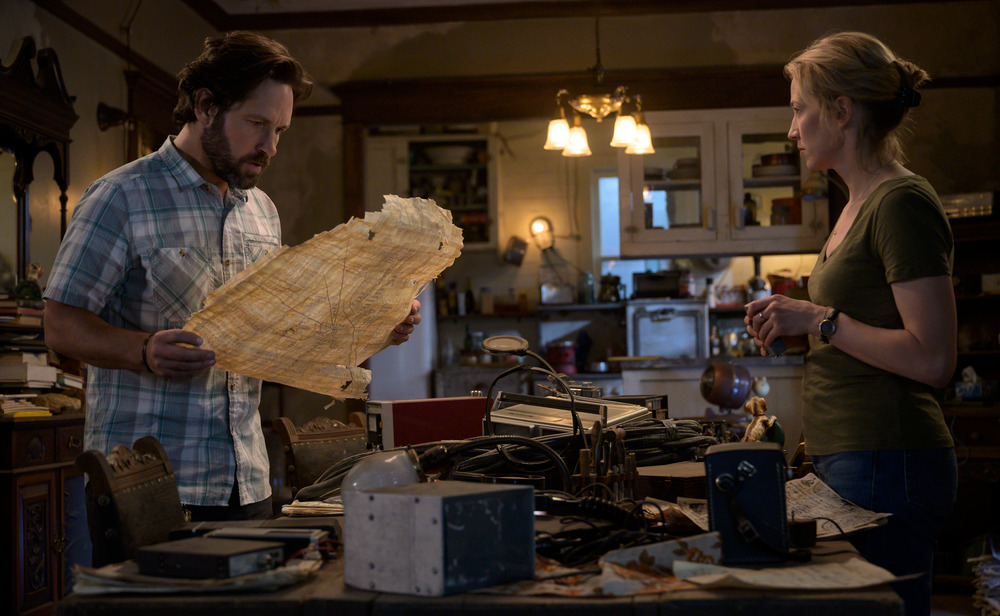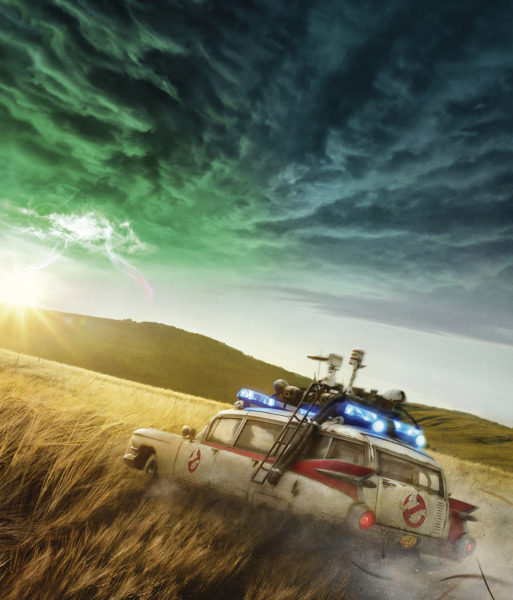Ghostbusters: Afterlife is a family affair. Unlike the previous three Ghostbusters films, it’s about a family: single mother Callie (Carrie Coon) and children Trevor (Finn Wolfhard) and Phoebe (Mckenna Grace), daughter and grandkids of the late, great ghostbuster Dr. Spengler (Harold Ramis). The idea of family legacy extends to behind the camera, as well, to director/co-writer Jason Reitman (Juno, Up in the Air, Thank You for Smoking) and his father, Ivan Reitman, who directed and produced the first two Ghostbusters films (and myriad other comedy classics) and returns as a producer this go-round.
It’s not surprising to learn that the younger Reitman grew up at the movies—and values the theatrical experience, especially now, when there are “fewer and fewer places of singular attention” and the industry was kept at a temporary standstill for so long. Reitman spoke exclusively to Boxoffice Pro about his history with movie theaters and the experience of making Ghostbusters: Afterlife, in theaters November 19.
Pre-Ghostbusters: Afterlife, you served as producer for most of the films you directed. How is the process different for you, when you’re also producing a film versus when you’re not?
From moment one, it made sense on this film for my father and I to partner up that way. My father’s a producer [on Ghostbusters: Afterlife]. I am the director. We knew that we were going to enter in a different producer-director relationship than any filmmaking team ever has, even in cases where families have worked together on projects. My father was a producer on Up in the Air. It was a much different thing for me to pick up this story that he had created, and I think that’s what made this different.
For a lot of people, including myself, the first two Ghostbusters films are baked into our childhood. But this is the first Ghostbusters film to center on child characters—or at least to feature them in a big way. What was the thought process behind that shift? What does it bring to the story?
It’s interesting. If you think about the three Ghostbusters films up until now, they’ve always been about a group of people who go into business. That was always at the core of what their stories were about, and it’s what bonded the main characters. I wanted to make a movie about a family. That’s how the first kernels of the idea started coming to me, before I even really knew that I was going to make this film. I pitched it to my writing partner [Gil Kenan] as exactly that: It’s a movie about a single mom and her two kids. It’s about ghosts, both paranormal and figurative. It’s about a broken family.
It really came down to, what is it like to discover the ephemera of previous generations? What got me excited about it were those moments of going through my grandparents’ basement and finding my father’s short films from college. Those moments where you somehow discover who your family is by going through the attic or going through the basement or going through some old trunk. And I thought, what would it be like to find a proton pack in your grandparents’ basement? What would that mean about who you were? And thus began the story of these young people who have to figure out what this ghostbusting equipment is, why it’s there, and why it’s found its way into their hands.
Given the family-based nostalgia at the heart of this movie—I know you’ve worked with your father before, but with this one in particular—did the process change your relationship with him at all, professional or otherwise?
It was absolutely wonderful and very challenging. I ask of anyone: Imagine your father sitting next to you at work and in real time reviewing every decision you make. It is lovely to spend that much time with your parents. It is also really tricky. My father and I are both … [long pause]confident in our own opinions.
Good way of putting it.
Thank you. And it wasn’t always easy. But what I found myself thinking all the time was, my father was around the same age when he made Ghostbusters. And as I would revisit ideas and locations and props and music, I found myself wondering what was behind my father’s decisions at every turn. And the thrill was being able to actually just turn and ask him.
Was going to the movie theater a big part of your childhood?
I lived at the movie theater. The movie theater was my babysitter. I would be dropped off, and I would go from one screen to the next. But, as a child of privilege, I actually bought tickets for all the films I saw, so I wasn’t sneaking in from theater to theater.
That’s good! Our readers in exhibition will be happy to hear that.
There are fewer and fewer places of singular attention. And I cherish having them back. I’ve gone to the movies many times over the summer. I find myself returning not just for the movies, but for the act of being inside the movie theater. Buying the popcorn. Watching the trailers. Experiencing a screen bigger than my eyes can fathom. Real sound. And laughing and crying with strangers. These are things that I had been missing the last year. From Zola to A Quiet Place—I still haven’t seen The Suicide Squad. I’m just happy to have it back.
Zola was so good. The conversation among some people is, “Oh, the big screen is so important because where else can you really, fully experience these big, special-effects-laden spectacles?” But a film like Zola on the big screen—that was the place to see it.
One hundred percent agree. The music in Zola is amazing. The audience experience of Zola is amazing. One thing I’m jealous of you, you’re in New York, so you got to see Shiva Baby on a big screen, and I didn’t get to do that in LA. I finally watched that. Oh my God, that movie’s amazing. It is the most Jewish movie I’ve ever seen. It’s also just an amazing thriller. It’s fantastic.

Ghostbusters: Afterlife was originally supposed to come out in June 2020. When you did you finish it? Was it ages ago?
Yes and no. The movie’s been done for months. But also, we just added something for the end of the credits.
That was going to be my follow-up: Are you a tinkerer?
For the most part, no. I know directors kind of fall into two categories. I am definitely in the category of “… and I am done.” I am a director of instinct, and I generally follow that.
What’s it like seeing the final cut of a film, 100 percent done, in a theater for the first time? Because you’ve seen every other iteration of it, also on a big screen. Is it different when you know, “This is the movie”?
What’s different is finally seeing it with an audience. That was the big difference this year. When I think about my previous movies, they were all in a breakneck race for Telluride or Toronto, where we would finish the movie and three days later, we would be with an audience at a film festival watching the movie. It was a thrill, but I had no time to think about it. On Ghostbusters, for what feels like a year, we sat. And then finally we had a test screening of the movie. And it played beautifully. But I had to wait a long time to just sit amongst people eating popcorn watching the movie, to hear them laugh and cheer and gasp and be surprised. It was worth the wait. The exciting part was, having not seen it for a long time. I got to, in some ways, watch it for the first time again with them.
I hate to ascribe anything positive to the pandemic, but that sounds like a nice little silver lining. You get to take a step back and experience it for the first time.
Very well said. This is the first time I’ve watched one of my movies where I really felt like I was an audience member.
You mentioned going to the theater a lot as a kid—did you have a particular childhood theater that you went to most often?
I don’t know how familiar you are with L.A. I have so many movie theaters, I honestly don’t know where to begin. I grew up at the moment when the Westwood Village in Los Angeles was the epicenter of movie exhibition. People would line up around the corner at every one of the movie palaces. It was a privilege to wait two hours to see movies in late-’80s, early-’90s Westwood. I’d go to the Mann Village, and I’d go to the Bruin. All the way up to seeing Pulp Fiction at the UA, before they tore that down. The AMC Century 14—that was a huge theater for me. It’s the theater of my first kiss: Don’t Tell Mom the Babysitter’s Dead.
A very romantic film.
I remember when they built the CityWalk. It was a Cineplex Odeon at that time. That was a big theater for me. That’s one where I would just sit there all day. I would sometimes go theater to theater, just to watch the trailers. I remember when the Cliffhanger trailer came out. I would go to three theaters in a row just to watch that trailer over and over. But then I remember being in New York—I remember, with my dad, seeing Big Trouble in Little China in New York and RoboCop in New York and watching those movies crush.

I love trailers. There’s an art to them. The two Ghostbusters trailers that’ve come out so far have both been really good—they each evoked different tones and hit it in different ways.
I’m right there with you. The trailer is as much a part of my experience of a movie as the movie itself. They’re people who care. And I’m really lucky that [Co-Head of Motion Picture Group, formerly President of Worldwide Marketing and Distribution] Josh Greenstein over at Sony and [Sony Pictures Entertainment’s EVP Creative Advertising] David Fruchbom, who put together this trailer, understand and love Ghostbusters. And look, that’s the thing about this franchise. It exists before all of us. It doesn’t belong to any of us. Anyone who worked on this film knew that they were trying on someone else’s clothes. It was our job to honor that. Whether you were creating costumes or building puppets or doing practical effects or writing music—or, honestly, editing the trailer—there’s a reverence that was a part of the work. That had to be a part of the work. Because you’re cooking a recipe that people know. You know when someone’s gotten your grandma’s recipe right. And you know when they got it wrong.
You can’t see me, obviously, but when you said “practical effects,” I did the human equivalent of a dog’s ears perking up when they hear “dinnertime.”
That’s all part of the language of the movie, right? That was something I really admired about J.J. [Abrams’s] The Force Awakens. It was made by not only a person, but by people who clearly love Star Wars. When you watch Force Awakens, you knew that BB-8 was practical. And you could tell that they wanted to get the patina of the Star Destroyers and the X-Wings and the buttons and the clothes and the puppets. They all felt of a world that you’re just as familiar with as you are your own world.
I’m in my mid-30s, and I won’t claim to know what teenagers today grew up with. Had Finn and Mckenna seen Ghostbusters?
Oh, oh, oh. Mckenna had been a Ghostbuster multiple times for Halloween as a young child. Mckenna used to do paintings of Slimer. Mckenna was a Ghostbusters fanatic. The day that she got to put on a proton pack for the first time, she squealed, she cried. This was a huge deal for her. And Finn is a student of comedy, a student of film, a student of Dan Aykroyd and Harold Ramis. They were very much of this world.
As long as they both appreciated Annie Potts’s Janine being back. That was my favorite moment from the trailer.
Every day, it’d be like, “You know, tomorrow, you’re working with so-and-so.” Or “Tomorrow, you’re going to work with this.” Or “Tomorrow, you get to hold that.” Or “Tomorrow, you’re driving Ecto-1.” And they freak out every single time! The number of times one of them looked at me—and this is for [child actors] Celeste [O’Connor] and Logan [Kim] as well—and went, “How cool is this?” But Paul Rudd was the same way!
And that must come through on the screen—that they’re really having a good time, and it’s not just a paycheck role.
There isn’t a day on the set of Ghostbusters that you are not somehow interacting with something that you fell in love with as a kid.



Share this post